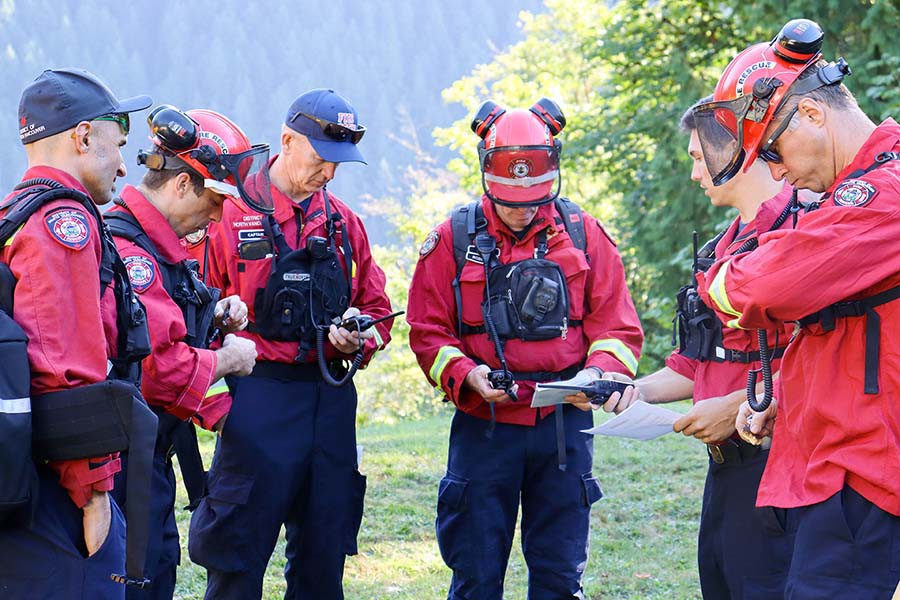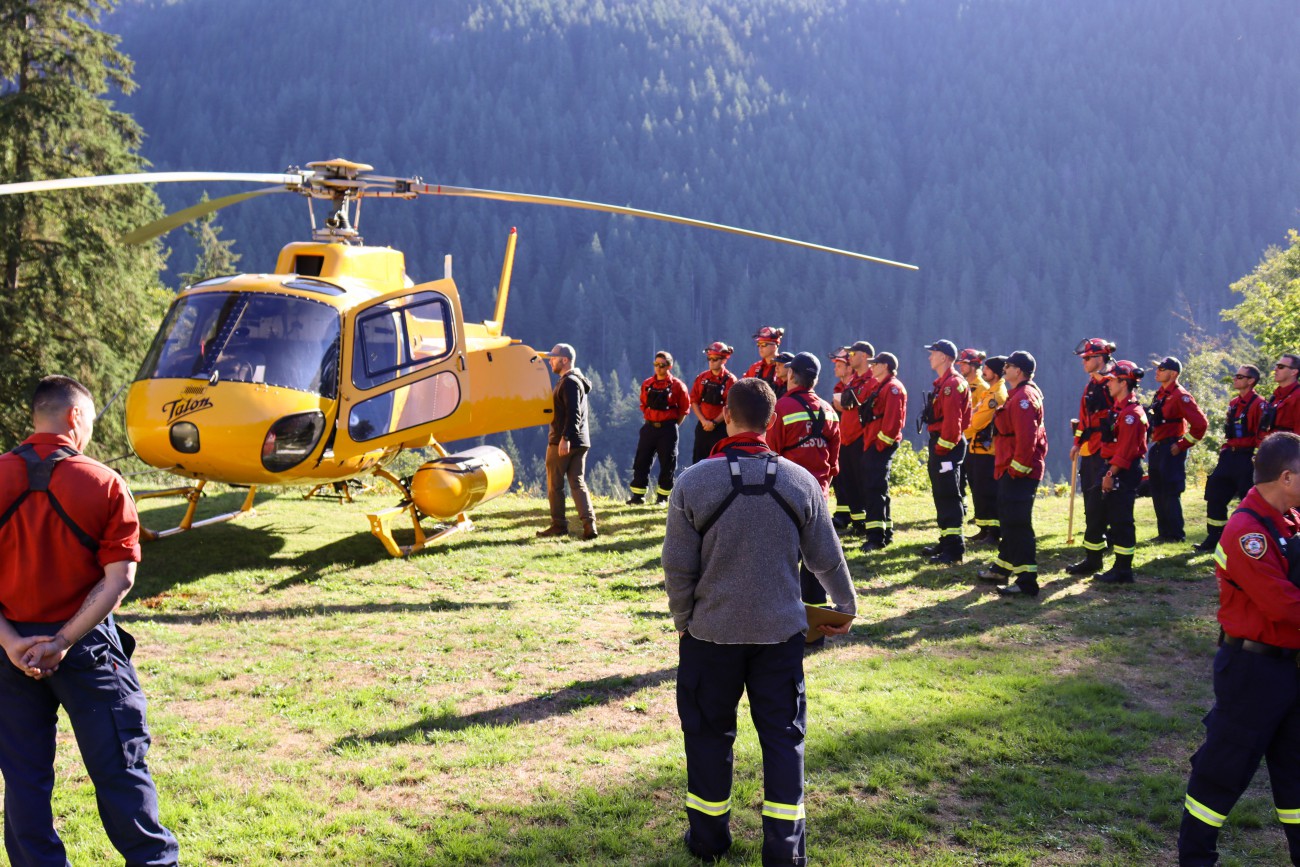Wildfire preparedness and response
With more than 1,600 fires burning nearly 8,700 square kilometres of land this year, the 2021 wildfire season in BC was the third-worst on record in terms of area burned.
Many of these fires burned dangerously close to communities. Two of the most notable and devastating wildfires in 2021 were the Lytton Creek and White Rock Lake wildfires, both of which had DNVFRS personnel in key leadership roles sharing experience and expertise.
We have long recognized that the District of North Vancouver has a significant area where our community meets the forest, which may be especially vulnerable to wildfire damage. Therefore, we enhance our wildfire preparedness and readiness capabilities through programs, partnerships, and training, as well as grant and funding opportunities.
Our approach has been and continues to be a multi-year effort that entails creative and innovative initiatives and building close working relationships with key partners.
Wildfire Deployments
In 2021, the DNVFRS supported the provincial response to the wildfire season by filling 45 positions for BC Wildfire Service throughout the summer. Our foremost priority is protecting and serving the residents of the District of North Vancouver, and our deployments are only undertaken when we can ensure appropriate personnel and resources remain response ready for the DNV. Here’s a brief overview of these deployments:
Command Positions
- Lytton Creek – We deployed a chief officer to serve as an Agency Representative from the Office of the Fire Commissioner to the Incident Management Team. This role provided strategic liaison with all responding agencies and supported local government through the crisis.
- Deka Lake (100 Mile House) – We deployed a chief officer as a Task Force Leader to this incident to provide tactical oversight of firefighting resources used to defend homes and structures.
- White Rock Lake - DNVFRS filled four Task Force Leader positions over a month-long period. Structure defense operations in the North Division (Westwold) and South Division (Fintry) had night operations oversight by the DNVFRS, providing leadership to firefighting resources from across the province.
Structure Protection
DNVFRS personnel are trained to provide many specialty disciplines, including our Structure Protection Crews and Structure Protection Units, which deployed throughout the province this wildfire season to protect threatened homes and infrastructure.
- McKay Creek (Lillooet) – We deployed a five-person Structure Protection Crew for 10 days to this incident.
- Bill Nye Mountain (Cranbrook) – We deployed a second five-person Structure Protection Crew deployed with one of our Structure Protection Units to this incident. During the nine-day deployment, they undertook operations at Okanagan Falls, Vernon, and finally protecting structures outside Cranbrook.
- Tremont Creek (Ashcroft/Cache Creek) – For over six weeks, DNVFRS personnel serving on our five-person Structure Protection Crews alongside our deployed Structure Protection Units conducted operations as a core element for this incident. We rotated our five-person crews every 14 days.
Structure Defense
- Logan Lake – As this incident progressed rapidly and the Town of Logan Lake was in imminent threat, DNVFRS deployed a four-person fire engine to serve in a structure defense role. This eight-day deployment saw one of our Reserve Fire Engines helping to protect this community.
Wildfire FAQs
What does a Task Force Leader do?
The Task Force Leader directs a large combination of personnel, crews and different equipment during wildland fire incidents. All chief officers at DNVFRS are qualified as Task Force Leaders through the BC Wildfire Service.
What is a Structure Protection Unit and how many does DNVFRS have?
A Structure Protection Unit (SPU) is a cache of equipment stored in a trailer used by trained specialists to set up sprinklers on and around a structure. SPUs can effectively reduce wildfire threats to some types of buildings, such as houses, cabins, barns or other outbuildings. Each SPU can protect upwards of 35 homes or structures, and the DNVFRS has three of these units.
What is the difference between Structure Defense and Structure Protection?
Structure Defense is wildland firefighting and involves standard wildland strategy and tactics. It also may include removing wildland fuels around structures and using water enhancers and or foam on surrounding vegetation and the structures. Structure Protection strategies and tactics are used when there's a possibility that a wildfire could move into an urban environment. These specialists also use FireSmart principles that can be very useful to helping to protect homes and buildings in a wildfire's path.
Specialized Wildfire Training
Our firefighters participate in regular annual training to ensure we’re ready to respond to any wildfire threat quickly. In addition, the DNVFRS seeks out opportunities to innovate, implement best practices in the field, and introduce ground-breaking initiatives. Some highlights from our 2021 training programs and exercises included:
- Wildfire Initial Attack Crew (DNV-IAC) – This 25-person special teams program, unique to a BC municipal fire department, has been established to fight wildfires within or adjacent to the wildland areas of the District. These fires may be inaccessible to our fire engines, so personnel have the training to deploy and operate in remote settings for extended periods. The capacity to halt or control a wildfire before it infringes on our urban area is our goal.
- Interagency wildfire field exercise – In fall 2021, we held a full-day field exercise, deploying our Initial Attack Crew (DNV-IAC) alongside BC Wildfire Service and Metro Vancouver Watershed Protection initial attack and unit crew personnel.
- BC Wildfire Service ‘Engine Boss’ – In 2021, the Office of the Fire Commissioner and BC Wildfire introduced the Engine Boss course to BC. The District was selected as one of five locations across the province to host this program. Firefighters from 11 different departments travelled to the North Shore and participated in this practical, hands-on program to support wildland interface operations.
- Danger Tree Assessor Certification – In 2021, we recertified 11 of our danger tree assessors and added 13 new DTAs for a full complement of 29 certified personnel. This program supports our wildfire readiness by providing the knowledge and technical procedures for assessing tree hazards and establishing appropriate safe-work practices in situations with potential exposure from dangerous trees to workers on the fire line.
- Wildfire Response Engines – We acquired three new Wildfire Response Engines as part of our multi-year approach to building internal capacity to fight wildfires. These ‘Squads’ will serve a multi-purpose response role for the DNVFRS while also meeting the requirements needed to integrate into the BC Wildfire response system.
- Strategic Wildfire Working Group – In partnership with Metro Vancouver Watershed Protection, Coquitlam Fire/Rescue, and West Vancouver Fire & Rescue, we established this platform for interagency collaboration. As one of the three primary fire departments adjacent to the Capilano, Seymour, and Coquitlam watersheds, we have a vested interest in ensuring our approaches and responses at the strategic and tactical level are aligned and we can support one another through mutual aid.
Partnership with Metro Vancouver
We continue to work with Metro Vancouver Watershed Protection on a variety of initiatives to enhance our inter-agency relationship and increase our interoperability in the event of a wildfire emergency or technical rescue. We will continue to:
- Liaise with the Metro Vancouver Watershed Protection team on joint initiatives such as the Wildfire Initial Attack Crew (DNV-IAC) training, dangerous tree assessment, helicopter training and overall wildfire protection across the North Shore and in our two watersheds (Capilano and Seymour).
- Coordinate communications through weekly fire danger rating reports to update our new signage and social media channels throughout the hot and dry season.
FireSmart Community Program
Due to the early start of the 2021 wildfire season, there was a heightened concern for home and property safety in our community.
Our town hall meeting with the residents of the Indian Arm communities spurred individual neighbourhoods to request FireSmart presentations and, later, neighbourhood recognition. As a result, 15 neighbourhoods participated in the FireSmart Canada Neighbourhood Recognition Project (FSCNRP) program. DNVFRS members, trained as Local Fire Smart Representatives (LFRs), assessed and provided recommendations to reduce risks to property by wildfire and increase the community’s resiliency. As of 2021, we have 18 members qualified through FireSmart Canada as LFRs.
During the dry season, as part of the FireSmart door hanger program, our firefighters, public safety personnel, chief officers, administrative staff, and District park rangers delivered outdoor burning information to 3,271 homes in the urban interface and wildfire development permit area.
Members trained as Local FireSmart Representatives performed FireSmart assessments of 66 critical First Nations and publicly owned buildings.
We will continue to partner with the community and other agencies on the North Shore to increase FireSmart awareness and community risk reduction by meeting weekly with these partners to discuss information about potential fire dangers and preparedness tactics when the fire danger rating reaches high or extreme.
Community Wildfire Protection Plan
Urban interface fires typically require more personnel and equipment resources than any single department has available, so cooperation and coordination between multiple departments, agencies, and organizations is required.
Our Community Wildfire Protection Plan (CWPP), updated in 2020, helps us prepare for, respond to, and recover from wildfires, particularly in areas where our community meets the forest, known as the “wildland urban interface.”
The CWPP contains 52 recommendations for improving our emergency response and training, community education, emergency communications, building practices, and more to make the district as fire-safe as possible. DNVFRS is moving forward with many of these recommendations.
Download the Wildfire Protection Plan


